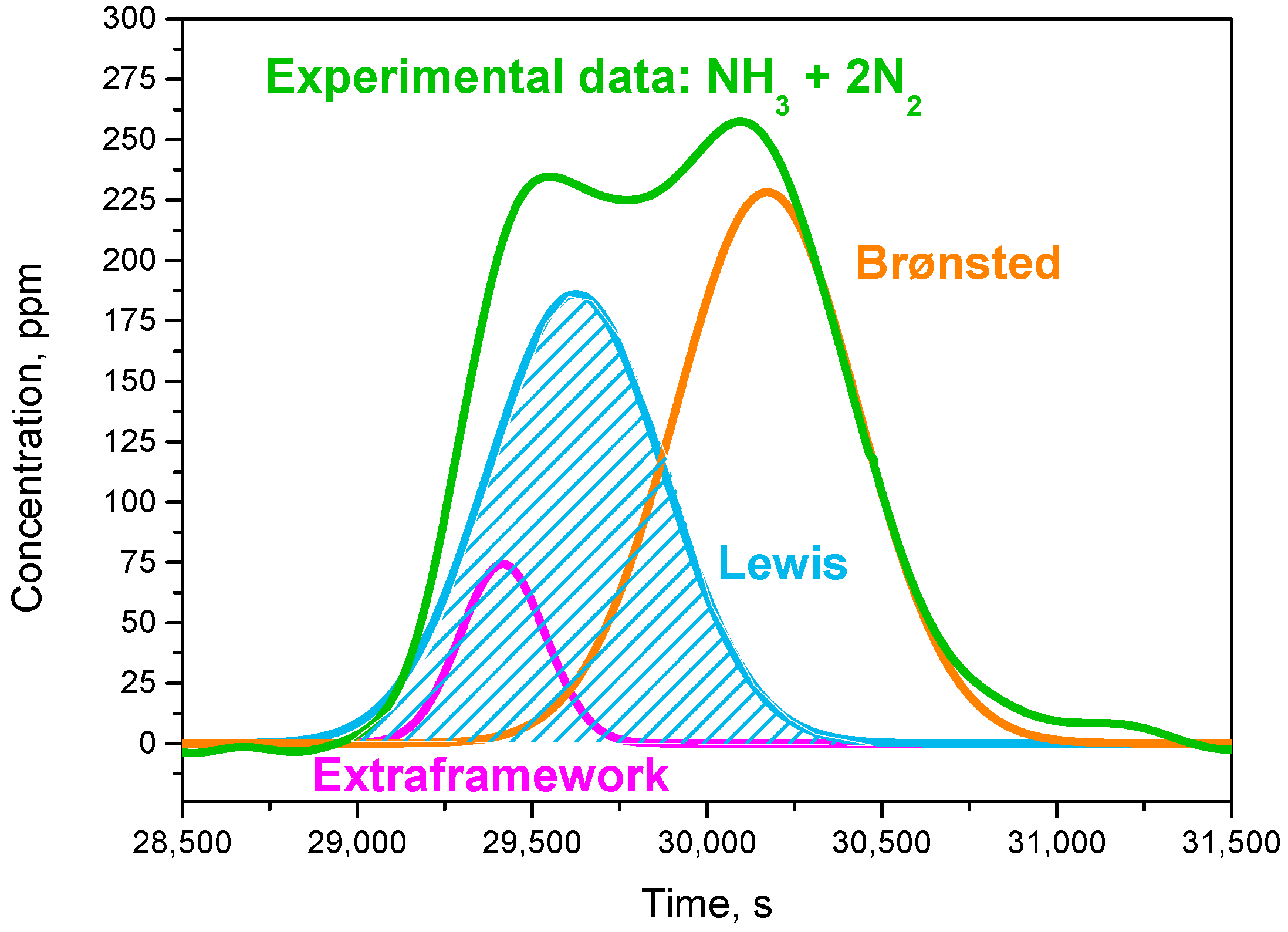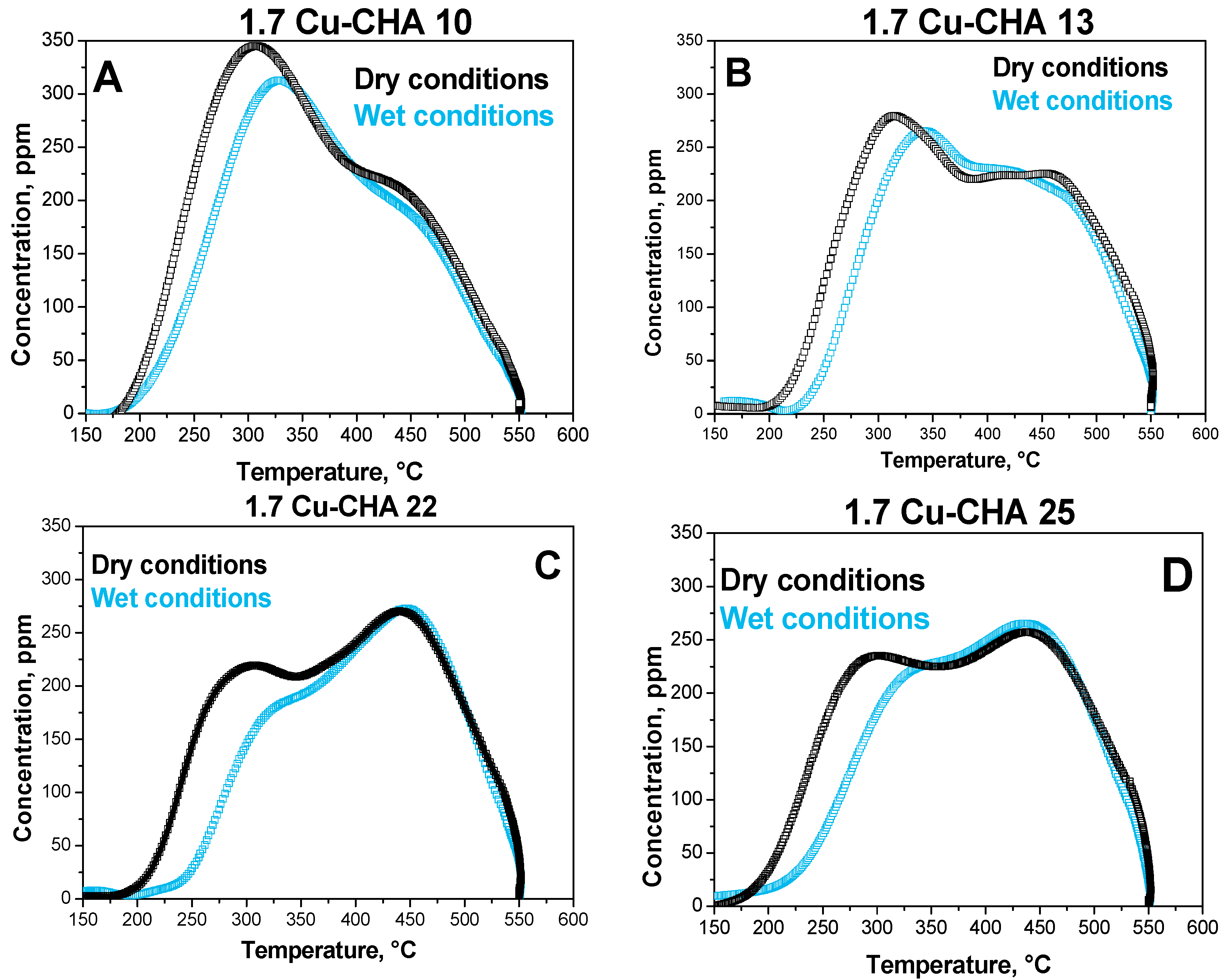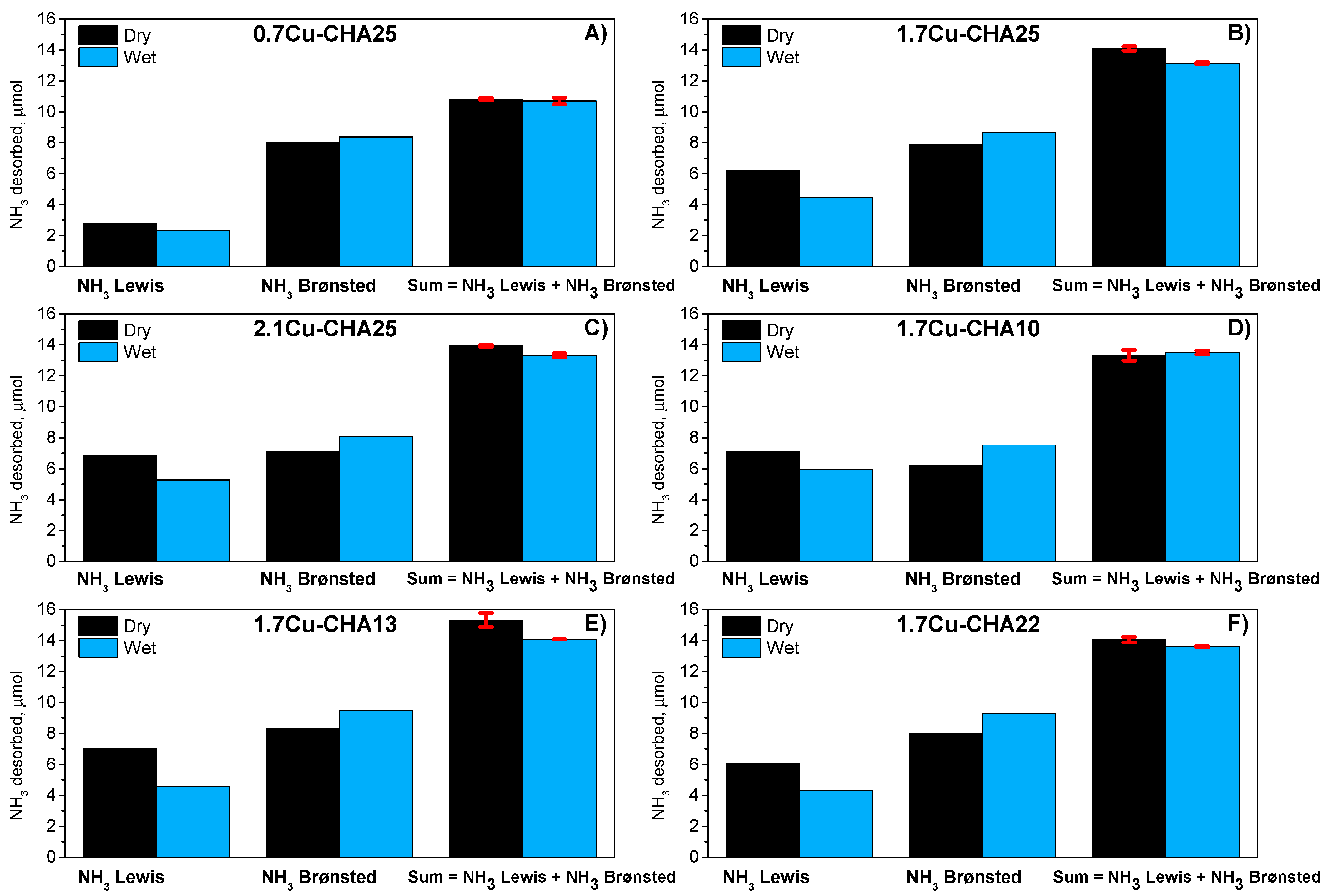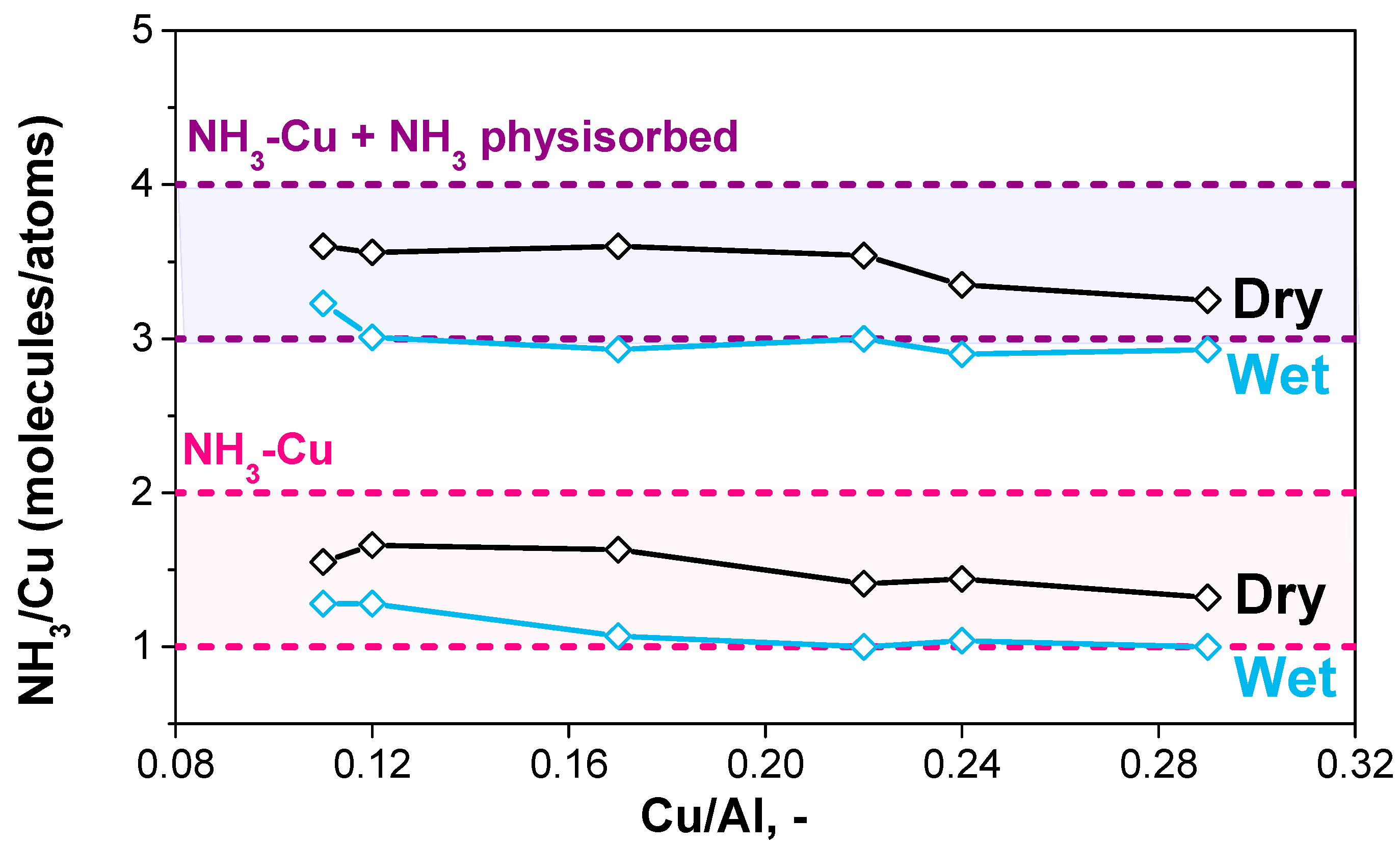The H2O Effect on Cu Speciation in Cu-CHA-Catalysts for NH3-SCR Probed by NH3 Titration
Abstract
:1. Introduction
2. Results and Discussion
2.1. H2O Effect with Changes in Cu Loading
2.2. Water Effect with Changes in SAR
2.3. H2O Effect on Cu Speciation
3. Material and Methods
4. Conclusions
Supplementary Materials
Author Contributions
Funding
Institutional Review Board Statement
Informed Consent Statement
Conflicts of Interest
References
- Güthenke, A.; Chatterjee, D.; Weibel, M.; Krutzsch, B.; Kočí, P.; Marek, M.; Nova, I.; Tronconi, E. Current status of modeling lean exhaust gas aftertreatment catalysts. Adv. Chem. Eng. 2007, 33, 103–283. [Google Scholar] [CrossRef]
- Nova, I.; Tronconi, E. Urea-SCR Technology for deNOx After Treatment of Diesel Exhausts; Springer: New York, NY, USA, 2014. [Google Scholar]
- Wang, D.; Zhang, L.; Li, J.; Kamasamudram, K.; Epling, W.S. NH3-SCR over Cu/SAPO-34-Zeolite acidity and Cu structure changes as a function of Cu loading. Catal. Today 2014, 231, 64–74. [Google Scholar] [CrossRef]
- Luo, J.; Gao, F.; Kamasamudram, K.; Currier, N.; Peden, C.H.F.; Yezerets, A. New insights into Cu/SSZ-13 SCR catalyst acidity. Part I: Nature of acidic sites probed by NH3 titration. J. Catal. 2017, 348, 291–299. [Google Scholar] [CrossRef] [Green Version]
- Paolucci, C.; Parekh, A.A.; Khurana, I.; Di Iorio, J.R.; Li, H.; Albarracin Caballero, J.D.; Shih, A.J.; Anggara, T.; Delgass, W.N.; Miller, J.T.; et al. Catalysis in a cage: Condition-dependent speciation and dynamics of exchanged cu cations in ssz-13 zeolites. J. Am. Chem. Soc. 2016, 138, 6028–6048. [Google Scholar] [CrossRef] [PubMed]
- Gao, F.; Peden, C.H.F. Recent progress in atomic-level understanding of Cu/SSZ-13 selective catalytic reduction catalysts. Catalysts 2018, 8, 140. [Google Scholar] [CrossRef] [Green Version]
- Rizzotto, V.; Chen, D.; Tabak, B.M.; Yang, J.Y.; Ye, D.; Simon, U.; Chen, P. Spectroscopic identification and catalytic relevance of NH4+ intermediates in selective NOx reduction over Cu-SSZ-13 zeolites. Chemosphere 2020, 250, 126272. [Google Scholar] [CrossRef] [PubMed]
- Villamaina, R.; Liu, S.; Nova, I.; Tronconi, E.; Ruggeri, M.P.; Collier, J.; York, A.; Thompsett, D. Speciation of Cu Cations in Cu-CHA Catalysts for NH3-SCR: Effects of SiO2/AlO3 Ratio and Cu-Loading Investigated by Transient Response Methods. ACS Catal. 2019, 9, 8916–8927. [Google Scholar] [CrossRef]
- Song, J.; Wang, Y.; Walter, E.D.; Washton, N.M.; Mei, D.; Kovarik, L.; Engelhard, M.H.; Prodinger, S.; Wang, Y.; Peden, C.H.F.; et al. Toward Rational Design of Cu/SSZ-13 Selective Catalytic Reduction Catalysts: Implications from Atomic-Level Understanding of Hydrothermal Stability. ACS Catal. 2017, 7, 8214–8227. [Google Scholar] [CrossRef]
- Fan, C.; Chen, Z.; Pang, L.; Ming, S.; Zhang, X.; Albert, K.B.; Liu, P.; Chen, H.; Li, T. The influence of Si/Al ratio on the catalytic property and hydrothermal stability of Cu-SSZ-13 catalysts for NH3-SCR. Appl. Catal. A Gen. 2018, 550, 256–265. [Google Scholar] [CrossRef]
- Gao, F.; Washton, N.M.; Wang, Y.; Kollár, M.; Szanyi, J.; Peden, C.H.F. Effects of Si/Al ratio on Cu/SSZ-13 NH3-SCR catalysts: Implications for the active Cu species and the roles of Brønsted acidity. J. Catal. 2015, 331, 25–38. [Google Scholar] [CrossRef] [Green Version]
- Daya, R.; Joshi, S.Y.; Luo, J.; Dadi, R.K.; Currier, N.W.; Yezerets, A. On kinetic modeling of change in active sites upon hydrothermal aging of Cu-SSZ-13. Appl. Catal. B Environ. 2020, 263, 118368. [Google Scholar] [CrossRef]
- Borfecchia, E.; Negri, C.; Lomachenko, K.A.; Lamberti, C.; Janssens, T.V.W.; Berlier, G. Temperature-dependent dynamics of NH3-derived Cu species in the Cu-CHA SCR catalyst. React. Chem. Eng. 2019, 4, 1067–1080. [Google Scholar] [CrossRef]
- Giordanino, F.; Borfecchia, E.; Lomachenko, K.A.; Lazzarini, A.; Agostini, G.; Gallo, E.; Soldatov, A.V.; Beato, P.; Bordiga, S.; Lamberti, C. Interaction of NH3 with Cu-SSZ-13 catalyst: A complementary FTIR, XANES, and XES study. J. Phys. Chem. Lett. 2014, 5, 1552–1559. [Google Scholar] [CrossRef]
- Ruggeri, M.P.; Nova, I.; Tronconi, E.; Collier, J.E.; York, A.P.E. Structure–Activity Relationship of Different Cu–Zeolite Catalysts for NH3–SCR. Top. Catal. 2016, 59, 875–881. [Google Scholar] [CrossRef]
- Hu, W.; Selleri, T.; Gramigni, F.; Fenes, E.; Rout, K.R.; Liu, S.; Nova, I.; Chen, D.; Gao, X.; Tronconi, E. On the Redox Mechanism of Low-Temperature NH3-SCR over Cu-CHA: A Combined Experimental and Theoretical Study of the Reduction Half Cycle. Angew. Chem. 2021, 133, 7273–7280. [Google Scholar] [CrossRef]
- Gao, F.; Wang, Y.; Washton, N.M.; Kollár, M.; Szanyi, J.; Peden, C.H.F. Effects of Alkali and Alkaline Earth Cocations on the Activity and Hydrothermal Stability of Cu/SSZ-13 NH3-SCR Catalysts. ACS Catal. 2015, 5, 6780–6791. [Google Scholar] [CrossRef]
- Han, S.; Ye, Q.; Cheng, S.; Kang, T.; Dai, H. Effect of the hydrothermal aging temperature and Cu/Al ratio on the hydrothermal stability of CuSSZ-13 catalysts for NH3-SCR. Catal. Sci. Technol. 2017, 7, 703–717. [Google Scholar] [CrossRef]
- Bagnasco, G. Improving the selectivity of NH3 TPD measurements. J. Catal. 1996, 159, 249–252. [Google Scholar] [CrossRef]
- Sjovall, H.; Blint, R.J.; Olsson, L. Detailed Kinetic Modeling of NH3 and H2O Adsorption, and NH3 Oxidation over Cu-ZSM-5. J. Phys. Chem. C 2009, 113, 1393–1405. [Google Scholar] [CrossRef]
- Bolis, V.; Busco, C.; Ugliengo, P. Thermodynamic study of water adsorption in high-silica zeolites. J. Phys. Chem. B 2006, 110, 14849–14859. [Google Scholar] [CrossRef] [PubMed]
- Gao, F.; Mei, D.; Wang, Y.; Szanyi, J.; Peden, C.H.F. Selective Catalytic Reduction over Cu/SSZ-13: Linking Homo- and Heterogeneous Catalysis. J. Am. Chem. Soc. 2017, 139, 4935–4942. [Google Scholar] [CrossRef] [PubMed]
- Paolucci, C.; Khurana, I.; Parekh, A.A.; Li, S.; Shih, A.J.; Li, H.; Di Iorio, J.R.; Albarracin-Caballero, J.D.; Yezerets, A.; Miller, J.T.; et al. Dynamic multinuclear sites formed by mobilized copper ions in NOx selective catalytic reduction. Science 2017, 357, 898–903. [Google Scholar] [CrossRef] [Green Version]
- Godiksen, A.; Isaksen, O.L.; Rasmussen, S.B.; Vennestrøm, P.N.R.; Mossin, S. Site-Specific Reactivity of Copper Chabazite Zeolites with Nitric Oxide, Ammonia, and Oxygen. ChemCatChem 2018, 10, 366–370. [Google Scholar] [CrossRef]
- Hun Kwak, J.; Zhu, H.; Lee, J.H.; Peden, C.H.F.; Szanyi, J. Two different cationic positions in Cu-SSZ-13? Chem. Commun. 2012, 48, 4758–4760. [Google Scholar] [CrossRef] [PubMed]
- Rutkowska, M.; Duda, M.; Kowalczyk, A.; Chmielarz, L. Modification de la zéolithe CHA commerciale pour les besoins de la réduction catalytique des oxydes d’azote. C. R. Chim. 2017, 20, 850–859. [Google Scholar] [CrossRef]
- McEwen, J.S.; Anggara, T.; Schneider, W.F.; Kispersky, V.F.; Miller, J.T.; Delgass, W.N.; Ribeiro, F.H. Integrated operando X-ray absorption and DFT characterization of Cu-SSZ-13 exchange sites during the selective catalytic reduction of NOx with NH3. Catal. Today 2012, 184, 129–144. [Google Scholar] [CrossRef]






| 1.7Cu-CHA25 | |
|---|---|
| Cutot (ICP) (µmol) | 4.3 |
| NH3 adsorbed (µmol) | 23.4 |
| NH3 physisorbed (µmol) | 8.0 |
| NH3 chemissorbed (µmol) | 14.1 |
| N2 produced (µmol) | 0.7 |
| N balance error w/o N2 (%) | 5.6 |
| N balance error with N2 (%) | 0.1 |
| Sample | Cu Loaded, µmol | Z2CuII from NO2 Adsorption, µmol [8] | NH3 Brønsted dry, µmol | NH3 Brønsted wet, µmol | Z2CuII Hydrolised/Initial Z2CuII, % | Z2CuII Hydrolised/Cutot, % |
|---|---|---|---|---|---|---|
| 0.7% w/w Cu, SAR = 25 | 1.8 | 0.8 | 8.02 | 8.38 | 45 | 20 |
| 1.7% w/w Cu, SAR = 25 | 4.3 | 1.8 | 7.9 | 8.67 | 43 | 19 |
| 2.1% w/w Cu, SAR = 25 | 5.2 | 1.7 | 7.07 | 8.07 | 59 | 19 |
| 1.7% w/w Cu, SAR = 10 | 4.3 | 2.4 | 6.20 | 7.54 | 56 | 31 |
| 1.7% w/w Cu, SAR = 13 | 4.3 | 3.1 | 8.30 | 9.50 | 39 | 28 |
| 1.7% w/w Cu, SAR = 22 | 4.3 | 1.8 | 8.00 | 9.28 | 71 | 30 |
| Sample | Cu Loaded, µmol | Cu/Al Ratio, - | NO2 Adsorption Experiment, µmol | ZCuIIOH, % | Z2CuII, % | NOx Conversion at 225 °C, % |
|---|---|---|---|---|---|---|
| 0.7% w/w Cu, SAR = 25 | 1.8 | 0.11 | 1.0 | 55 | 45 | 16 |
| 1.7% w/w Cu, SAR = 25 | 4.3 | 0.24 | 2.5 | 58 | 42 | 91 |
| 2.1% w/w Cu, SAR = 25 | 5.2 | 0.29 | 3.5 | 67 | 33 | 96 |
| 1.7% w/w Cu, SAR = 10 | 4.3 | 0.12 | 1.9 | 44 | 56 | 58 |
| 1.7% w/w Cu, SAR = 13 | 4.3 | 0.17 | 1.2 | 28 | 72 | 67 |
| 1.7% w/w Cu, SAR = 22 | 4.3 | 0.22 | 2.5 | 58 | 41 | 83 |
Publisher’s Note: MDPI stays neutral with regard to jurisdictional claims in published maps and institutional affiliations. |
© 2021 by the authors. Licensee MDPI, Basel, Switzerland. This article is an open access article distributed under the terms and conditions of the Creative Commons Attribution (CC BY) license (https://creativecommons.org/licenses/by/4.0/).
Share and Cite
Villamaina, R.; Gramigni, F.; Iacobone, U.; Liu, S.; Nova, I.; Tronconi, E.; Ruggeri, M.P.; Collier, J.; York, A.P.E.; Thompsett, D. The H2O Effect on Cu Speciation in Cu-CHA-Catalysts for NH3-SCR Probed by NH3 Titration. Catalysts 2021, 11, 759. https://doi.org/10.3390/catal11070759
Villamaina R, Gramigni F, Iacobone U, Liu S, Nova I, Tronconi E, Ruggeri MP, Collier J, York APE, Thompsett D. The H2O Effect on Cu Speciation in Cu-CHA-Catalysts for NH3-SCR Probed by NH3 Titration. Catalysts. 2021; 11(7):759. https://doi.org/10.3390/catal11070759
Chicago/Turabian StyleVillamaina, Roberta, Federica Gramigni, Umberto Iacobone, Shaojun Liu, Isabella Nova, Enrico Tronconi, Maria Pia Ruggeri, Jillian Collier, Andrew P. E. York, and David Thompsett. 2021. "The H2O Effect on Cu Speciation in Cu-CHA-Catalysts for NH3-SCR Probed by NH3 Titration" Catalysts 11, no. 7: 759. https://doi.org/10.3390/catal11070759
APA StyleVillamaina, R., Gramigni, F., Iacobone, U., Liu, S., Nova, I., Tronconi, E., Ruggeri, M. P., Collier, J., York, A. P. E., & Thompsett, D. (2021). The H2O Effect on Cu Speciation in Cu-CHA-Catalysts for NH3-SCR Probed by NH3 Titration. Catalysts, 11(7), 759. https://doi.org/10.3390/catal11070759







